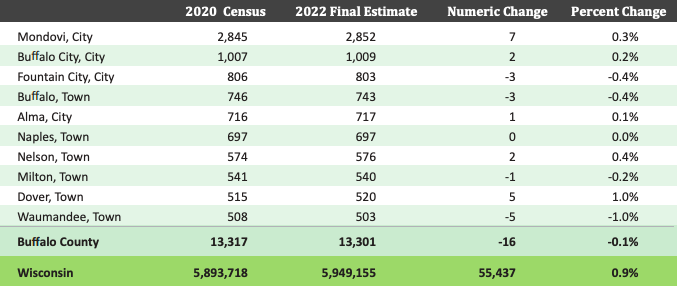Buffalo County Economic Development:
Buffalo County
Buffalo County is the sixth least populated county among Wisconsin’s 72 counties. With an estimate of 13,301 residents in 2022, the county’s population has remained stable in the first two years of this decade. The county lost 16 residents, equivalent to 0.1% of its population. By comparison, Wisconsin experienced population growth of 0.94% and the United States experienced population growth of 0.3% over the same period. Of the county’s 10 most populous municipalities, the City of Mondovi gained the most residents (7), while the Town of Waumandee lost the most residents (-5).
In April of 2020, Buffalo County’s unemployment rate peaked at 18.4%, significantly higher than the rates following the 2008 financial crisis. In November 2021, nearly two years after this initial spike, the unemployment rate fell to a historic low of 2.6%. However, the rapid economic recovery came at the cost of high inflation. In June 2022, the Consumer Price Index for All Urban Consumers increased 9.1% year-over-year, the largest increase in 40 years. The economy began to slow down as the Federal Reserve raised interest rates to tackle inflation. The unemployment rate increased to 3.6% in December of 2022.
Employment Changes By Industry

In Buffalo County, the leisure and hospitality industry suffered both the greatest numerical and proportional loss in 2020 because of the pandemic. However, like in many rural counties, the industry experienced a strong recovery over the course of 2021. Employment in the industry grew by 25%, adding 79 jobs during the year, exceeding the 2019 level by 1.8%. The strong growth was encouraging, and the industry has potential to continue its expansion as more leisure activities had shifted from urban area to rural since the pandemic. The manufacturing industry saw a 14.1% growth during the year 2021, the second highest in the county. In contrast, the manufacturing industry in the state grew roughly 1.6% during the same time frame.
Transportation
Buffalo County is a rural county. There is no local or intercity public transit system available in the county as of 2022. Over half of the residents travel outside of the county for work, and 33.4% of those that work in the county reside in another county. As expected, 86.6% of employed county residents rely on a car to get to work. Over three quarters drive alone. The average commute time is 24.6 minutes. Car-centered infrastructure leads to a difficult conundrum. Qualified individuals could fill jobs if they had cars. However, some can’t afford cars without a good-paying job. Some employers address this issue by offering telecommuting and transportation reimbursement.
Housing
The Department of Housing and Urban Development (HUD) uses 30% of income as a guideline for housing affordability. Buffalo County has a lower share of renters allocating more than 30% of income for housing compared to the state. Nonetheless, approximately four out of 10 renters still pay more than 30% of income on housing. Over half of housing in Buffalo County is over 50 years old compared to 44.9% in Wisconsin a whole. Only 14.1% was built between 2000 and 2020, compared to 16.8% of housing constructing more affordable housing is a solution to reducing the cost burden; however, the county’s declining population has reduced the need for new housing. Further examination is needed to determine whether the existing housing stock is ready to accommodate growth and development.
Child Care
In Buffalo County, the monthly cost of care ranges from $795 for an infant to $522 for a school aged child. To put this cost in perspective, a household with median earnings in Buffalo County would need to use about 18% of their earnings on infant care. In addition to cost, residents struggle with access. There is no definitive source for access or availability relative to need. According to the YoungStar provider database, there are eight total providers with a potential capacity of 81 in Buffalo County. This database tracks approximately 82% of providers in the state. The county has a relatively low capacity when compared to the state. There are four child care slots for every 100 children under the age of 14 in Buffalo County compared to 14 statewide. Additionally, even families that have child care struggle with child care disruptions. Graphic 13: Child Care Cost Easing the cost and access burden would help more parents enter or participate more fully in the labor market. Employers could also help improve participation by providing flexibility to parents with child care responsibilities
